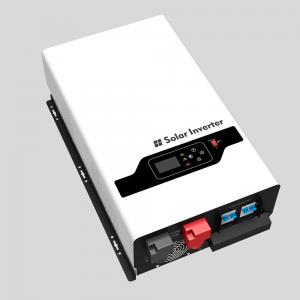
Add to Cart
Off Grid Solar Inverter (8-12KW)
| Inverter Output Output frequency | 50Hz / 60Hz ± 0.3Hz |
| Inverter Output Inverter effciency(peak) | >88% |
| Inverter Output Line mode efficiency | >95% |
| Inverter Output Power factor | 1.0 |
| Inverter Output Typical transfer time | 20ms(max) |
| AC Input Voltage | 230VAC |
| AC Input Selectable voltage range | 90-280 VAC (APL) |
| AC Input Frequency range | 50Hz / 60Hz |
FTPV3600 PRO series is a multi-function inverter ,combining functions of inverter and MPPT solar charger controller, solar charger and battery charger to offer uninterruptible power support. The comprehensive LCD display offers user-configurable and easy-accessible button operation such as battery charging current, AC/solar charger priority, and selectable input voltage based on different applications.


An off-grid solar inverter is a critical solar system component whose primary function is to convert direct current (DC) power captured by solar panels into alternating current (AC) power that can be used in home appliances and the grid (or battery storage system) .
Here’s how these inverters work:
DC to AC Conversion:
The electricity produced by solar panels is DC, but the electricity used in most home appliances and the power grid is AC. The main function of an inverter is to convert this DC power into usable AC power.
This process involves the use of electronic components and conversion technologies, such as thyristors and field-effect transistors, to convert incoming direct current into alternating current with a frequency, voltage, and waveform that meet the requirements of the grid.
Maximum Power Point Tracking (MPPT):
The output voltage and current of a solar panel vary with light intensity and temperature. MPPT technology is an important part of the inverter, adjusting the input voltage and current to maximize the power output of the solar panel.
This means that the inverter can provide optimal efficiency based on current light conditions and optimize the performance of the solar system under different conditions.
Safety protection and grid connection:
Off-grid inverters often have safety features such as overload protection, short circuit protection, and overheating protection to ensure safe system operation and prevent damage.
For systems connected to the grid, the inverter also needs to comply with grid connection specifications and have necessary safety measures, such as cutting off the connection in the event of a power outage or grid problem, to protect the grid and maintenance personnel.
Energy management and monitoring:
Some modern inverters have energy management and monitoring features that monitor the performance of the solar system, the amount of electricity produced, and the quality of the power in real time.
These features help users understand the health of their solar systems and optimize based on data to maximize energy utilization and system efficiency.
Overall, off-grid solar inverters are a key component of solar systems, providing important support for the utilization of clean, renewable energy by converting DC power generated by solar panels into AC power suitable for home and grid use.